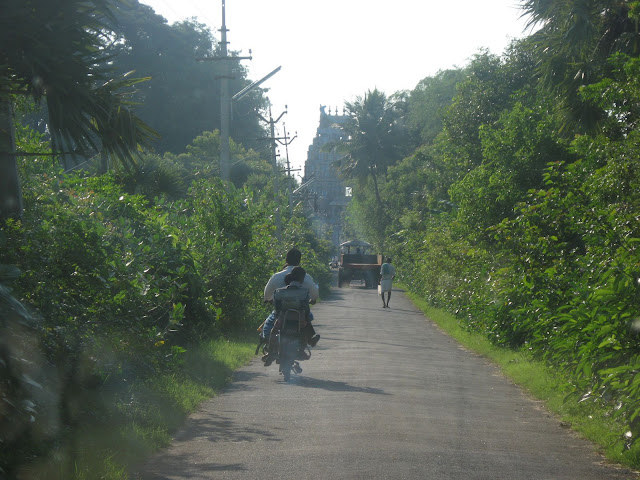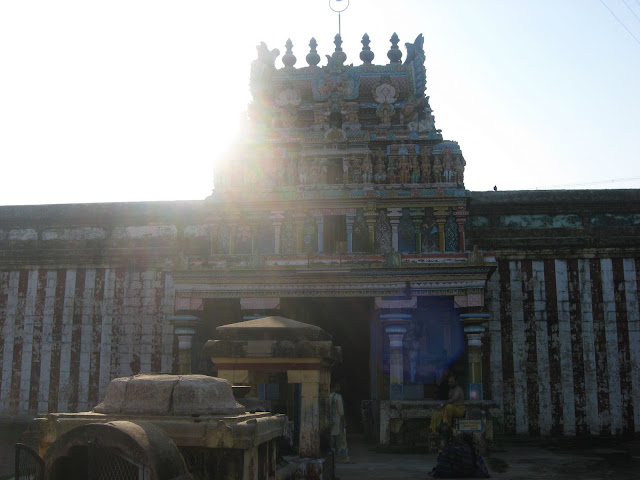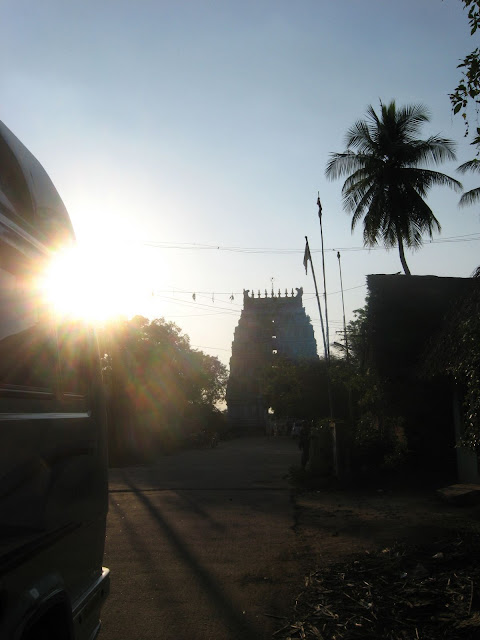The year was 1290 . A crowd had gathered around a clearing, where broken down pillars marked the presence of an ancient temple, now long gone. A young boy, just 14 years old, leaned against one of those pillars, deep in thought. Then, he began speaking, and the crowd fell silent, listening to his every word. He spoke without any notes, translating the Bhagavat Gita, from Sanskrit, which only the pundits knew, to the language everyone in the village knew and spoke – a variety of Prakrit which developed into the Marathi language. Even as he spoke, one of the men in the audience realized how momentous this event was, and how important this composition would be. He began writing down the words the young boy spoke, and this composition was named by its author and composer, the Bhavartha Deepika – the enlightening meaning (of the Bhagavat Gita). Now, the ancient, holy text, was no longer restricted to the pundits, but accessible to all, understood easily by them, composed as it was, in their...
Strength has always been one of the most admired qualities, and one has only to read history or mythology to see how much importance has been given to strength and the display of strength. One can find many temples all over India, all testifying to a victory of a god over a demon, or some special exhibition of greatness. There is a set of eight temples in the south of India, situated near Mayiladudurai, Thiruvarur and Thiruvannamalai, all of which are associated with displays of the strength and greatness of Shiva. At all these temples, Shiva has either vanquished a demon, or punished another god. These are collectively called the ‘Ashta Veeratta Sthalams’. Each of these temples is fascinating, and has special points of interest. What I find especially interesting is that 6 of these 8 temples have bronze statues depicting the story of the temple. These are statues that are absolutely invaluable and must be seen to be believed. Let’s take a tour of six of these temples that are situated around Mayiladudurai and Thiruvarur. These are:
The other two temples are in the vicinity of Thiruvannamalai, and I am yet to visit them.Vazhuvoor
 |
| From Diwali 08 - Thanjvur Trip |
To me, Vazhuvoor was the most interesting among the Ashta Veeratta Sthalams. Just before we started on our trip, we chanced upon a photo of Gajasamharamoorthy of Vazhuvoor in a Tamil magazine, and I was fascinated by it. I feel fortunate to have been able to view the bronze image with my own eyes, and have been waiting to share my experience with all o you.
 |
| From Diwali 08 - Thanjvur Trip |
Long long ago, when Vishnu took the form of Mohini during the churning of the ocean, Shiva was also enamored of the beautiful form, and arrived in the handsome form of Bhishandavar or Bhikshatanar. The union of these two great ones resulted in the birth of a child we know of as “Ayyappan”. Shiva continued to roam around the forests of the south in the same form, to where a group of sages were performing homams. Their wives, on seeing the beautiful form of Shiva, were absolutely lovelorn, and the sages were jealous and angry. In their anger, they forgot themselves, and performed the sacrifices usually performed in black magic, and brought forth terrible creatures and wild animals to scare away the handsome stranger, without realizing who it was. The most terrible of these creatures was a wild elephant who charged at Shiva, who took a miniscule form and entered the elephant. When Shiva entered the body of the elephant, the world grew dark at his absence, and everyone was frightened. Parvati, who was playing with Muruga at the moment, started carrying her son and began to run, when suddenly, Shiva appeared with 6 arms, holding different weapons in for of them, tearing open the body of the elephant, standing on the elephant’s head, and holding the torn skin with two of his hands. In such a form, he is known as ‘Gaja Samhara Moorthy’ – the destroyer of the elephant, which symbolizes all our negative desires and actions. This form has been beautifully depicted in a bronze statue in this temple. An interesting point of this image is that the inner side of the left foot of the lord is visible. This is the only image with such a feature, and this par is usually kept closed and opened only during the aarti. Accompanying Shiva in this form here is a statue of Parvati, holding Muruga in her arms, just running away. The statues are so life-like, one feels they will come to life at any moment. Though I wasn’t allowed to take a photo of the original sculpture, here is a photo of the image on the gopuram of the temple. This bronze image is kept secure and covered, and opened only when devotees arrive to see the deity. Behind this deity is a yantram, installed by the Paramacharya of Kanchi, to safeguard the potency of this powerful image.
 |
| From Diwali 08 - Thanjvur Trip |
Though the main deity here is Gajasamharamoorthy, the main deity in the sanctum is as usual, a Shiva lingam, where the lord takes the name of Kirtivasar, kirti being another name for elephant. The goddess here has a separate sanctum, and she goes by the name of Balakurambigai. It is believed that she blesses those who pray to her with progeny.
 |
| From Diwali 08 - Thanjvur Trip |
There are a number of other interesting things about this temple. There is a Sahasralingam (lingam with 1000 lingams inside) which, surprisingly, is placed outside the temple. Since this is apparently the birth place of Ayyappan, there is a small shrine about a few meters from the temple dedicated to him. Further, the temple has a bronze statue of the lord, which itself is unique. The image of Shaneeshwara here holds a bow and arrow, and Guru, who normally is antagonistic to him, faces Shani in this temple.
 |
| From Diwali 08 - Thanjvur Trip |
Vazhuvoor is about 9Kms from Mayiladudurai on the Thiruvarur road, and due to the condition of the roads, the journey takes about an hour by car.
Thirukkorukkai
 |
| From Diwali 08 - Thanjvur Trip |
The story of Kama being burnt to ashes for daring to shoot his arrows of love on Shiva, trying to get him to fall in love with Parvati is a famous one. One would imagine that this place would be somewhere in the north, near the Himalayas where Parvati was born. However, the site associated with this story in the south is a small village near Vaitheeswaran Kovil named Thirukkorukkai, originally known as Thirukurungai.
 |
| From Diwali 08 - Thanjvur Trip |
While this place is rather obscure, and we really had to search for it, the temple is an extremely beautiful one, with the gopuram decorated with stunning works of art, depicting the gods in beautiful forms. The main deity in this temple is Shiva as Yogeeswarar, since he was deep in meditation. His consort is Gyanambigai, who bestows knowledge on her devotees. The main Ganesha in this temple is known as Kurungai Vinayakar, probably derived from the name of the village. This temple does not have a bronze depiction of the story of Kama.
 |
| From Diwali 08 - Thanjvur Trip |
200 meters from the temple, is a pit in a sort of garden, which it is said, is filled with the ashes of Kama. While vehicles can approach this place, we elected to walk the short distance, and were rewarded by the sight of unspoilt countryside, both sides of the path covered by trees and flowering plants, butterflies by the hundreds milling around the flowers. The pit itself was overgrown with plants, since it had been raining till a few days back, and the earth was too wet to leave any remnants of dry ash. However, the local who accompanied us, took some mud from the centre of the pit and gave it to us. While it was wet, it still had the distinct odour of holy ash, or vibhuti, and over the next few days, as it dried, we saw it turn white in colour. The man explained to us that it was only in the pit that this white ash was found; the surrounding areas had red coloured mud.
 |
| From Diwali 08 - Thanjvur Trip |
 |
| From Diwali 08 - Thanjvur Trip |
Thirukkorukkai is about 15 Kms from Mayiladudurai, via Nidur and Palakkudi. It is nearer to Vaitheeswaran Kovil.
Thiruvirkudi
 |
| From Diwali 08 - Thanjvur Trip |
Jalandran was a demon king who became very strong, and captured all the 3 worlds. He wished to destroy the gods too, and advanced towards Shiva. Shiva destroyed Jalandran with a chakra (Discus) which he later gave to Vishnu. It is believed that Thiruvirkudi is the holy place where this took place, and it is here that Shiva is worshipped as Jalandran Samhara Moorthy. The bronze statue depicting the lord has him in a standing posture, holding a discus in his hand.
The main deity in the temple does not have a separate name, and is simply called Veerattaneswarar. The main deity is a lingam, while the Utsava moorthy is the bronze statue described above. The goddess is called Parimala Nayaki.
 |
| From Diwali 08 - Thanjvur Trip |
There are also other legends connected to this temple. Jalandran’s wife Brinda is believed to have been a great devotee of Vishnu, and also a righteous wife. It is believed that Shiva was able to kill Jalandran only after Vishnu took Jalandran’s form and deceived his wife, so that he would be deprived of her fidelity, thus rendering him mortal. When Brinda learnt of this ruse, she immolated herself, and Vishnu gave her the boon that she would appear as the Tulsi plant and would remain forever dear to him. Supporting this story is the sthala vriksham of this temple, or the temple plant, which is the Tulsi.
It is also believed that this is the place where Arjuna concealed his weapons during the year of concealment. He was granted a boon that the weapons would appear as snakes to anyone who approached them, and thus would remain safe.
Thirukkorukkai is about 22 Kms from Mayiladudurai and about 30 Kms from Sirkazhi. Thiruppariyalur
 |
| From Diwali 08 - Thanjvur Trip |
The story of Sati, her marriage to Shiva, and her father’s insulting her husband resulting in her self immolation is quite well known. It was then that Shiva danced his Tandava and killed Daksha, Sati’s father. Thiruppariyalur is dedicated to this episode in Shiva’s life, where he is known as Daksha Samhara Moorthy. As in the temple at Thiruvirkudi, here also the main deity, the lingam is named Veerattaneswarar and the Utsava Moorthy is a bronze idol of Daksha Samhara Moorthy, depicted as having Daksha under the lord’s feet.
Thiruppariyalur is about 13 Kms from Mayiladudurai and near Sembannar Kovil. Thirukkadaiyur
 |
| From Diwali 08 - Thanjvur Trip |
Sage Mrikandu and his wife prayed to Shiva for a child. Shiva gave them a choice – they could have a foolish son with a long life, or a short lived, but intelligent child. They chose the latter, and soon had a smart child, who came to be known as Markandeya. When, just before his 16th birthday, he learnt that he would die soon, he left home, and stayed in the temple, praying to Shiva, who was the one who had brought him to life. At the appointed hour, Yama (or Kaala) arrived to take his soul, and threw his noose of death over the child. Markandeya at once embraced the Shiva lingam, and the noose fell over the lingam. Shiva was furious and came out of the lingam, kicking Yama to death, thus stopping all death and saved Markandeya. However, with Yama’s death, there were no more deaths on earth, and Bhoomi Devi could bear the burden no more. Finally, Shiva yielded to their prayers, resurrecting Yama, and giving Markandeya eternal youth.
 |
| From Diwali 08 - Thanjvur Trip |
Thirukkadaiyur is the holy place where this legend is believed to have taken place, and here, the main deity is called Amritaghateswarar – the lord with the pot of nectar, who can confer immortality. The legend is depicted in the form of the bronze statue of Kaala Samhara Moorthy – Markandeya embracing the lingam out of which Shiva appears and kicks Yama. The lower portion of the statue showing the actual Samharam or killing of Yama is kept closed and opened only during the Aarti. Right opposite the sanctum of Kaala Samhara Moorthy is the sanctum of Yama, who is believed to be thanking the lord for allowing him to live.
The goddess here is Abirami, who is believed to have answered the prayers of a great devotee of hers, Abirami Bhattar, by bringing the full moon to the sky on a new moon night.
It is believed that at this temple, all the Navagrahas and even Yama owe their allegiance to Shiva, and hence prayers to Shiva can solve all problems, and in particular, increase the life span of people. The temple is at all times filled with multitudes of people who arrive to perform special pujas and homams on their birthdays, especially their 60th and 80th birthdays. Homams are conducted all day long, all around the pragaram and inside the sanctum yet there are waiting lists. This is among the most popular temples in the area.
Thirukkadaiyur is 20 Kms from Mayiladudurai and 45 Kms from Thirunallar.
These 5 temples are almost in the same area, around Mayiladudurai and can be covered in a single day, in fact within 5 to 6 hours.
Thirukandiyur
Thirukandiyur or Kandiyur is the site where Shiva curbed the ego of Brahma by cutting off his fifth head. It is believed that, at the beginning of creation, Brahma had 5 heads, and as he created one form of life after another, his ego grew, until he felt that he was the greatest of the gods. Shiva decided to teach him a lesson, and cut off Brahma’s fifth head, which stood on top of the other four. Brahma at once realized his error, and prayed to Shiva, asking for forgiveness. This temple also figures among the Saptha Sthaanam temples, where I have already described it. You can read about it here.
The main deity here is the Brahma Shira Kandeeswarar. There is no bronze idol depicting the story of this temple. The goddess is Mangalambigai. There is a nig statue of Brahma and Saraswati to the left of the lingam, facing it, in a separate sanctum.
Thirukandiyur is 3 Kms from Thiruvaiyaru on the Thiruvaiyaru – Thanjavur road.
While all these 6 temples are situated near Thanjavur and Kumbakonam, the two other temples are in the vicinity of Thiruvannamalai. The town nearest to these is Banrutti.
Thirukkovilur
The Vaishnava temple of Vamana or Trivikrama is a famous one. However, the same village also boasts of a Shiva temple, one of the Ashta Veeratta Sthalams, where Shiva is believed to have vanquished the demon Andhakasuran.
Thirukkovilur is about 37 Kms from Villupuram and about 30 Kms from Thiruvannamalai. It is about 20 Kms from Banrutti.
Thiruvadigai
Thiruvadigai is believed to be the place where Shiva vanquished the asura Tripura.
Thiruvadigai is about 3 Kms from Banrutti.
I have yet to visit the last two temples on this list. I have visited Thirukovilur before, but I was not aware of the Shiva temple. I have added these two temples in this blog so that those who visit the area might visit this temple too.
Very well written! Thank you.
ReplyDeleteThanks for Sharing Valuable Information on Temples.
ReplyDeleteFantastic compilation. Detailed and well written.
ReplyDeleteThanks for the detailed information.
ReplyDeleteMa'am, Thank you for the information you have compiled presented and shared with us
ReplyDelete